Inflancka Housing Complex
Located between Inflancka and Dzika Streets, this housing complex was built in the 1970s using prefabricated slabs of reinforced-steel concrete. Each building was assembled, floor by floor, from one-story-high H-shaped panels. Similar panel buildings were built in Warsaw’s Służew nad Dolinką neighborhood, which also served as a location for scenes in The Decalogue.
Decalogue One
In Krzysztof Kieślowski’s Decalogue, the modern world—one in which people of different generations and professions cross paths, each torn by different passions, and each confronting lesser or greater universal problems in their daily lives—is manifested in a neighborhood of prefabricated apartment buildings, the concrete panel constructions typical of twentieth-century European architecture. The director had attempted, since the early 1970s, to produce a short documentary about the apartment complex, a new urban borough gradually rising from a barren construction site. His initial intention was to shoot this six-minute film from one vantage point over the course of several years, concluding with a close-up of one window, showing a young man and woman meeting in an apartment. This would be followed by a sequence depicting the subsequent stages of their lives: their first kiss, pregnancy, and, finally, the new parents enjoying breakfast with their kids. As the film concludes, the camera draws back to a wide shot of the housing complex. As the film, titled Narodziny (Birth), drew closer to production, Kieślowski began scouting around for the best location. His shortlist contained five new residential neighborhoods under construction in Warsaw: Stegny, Służew, Marymont, Ursynów, and the complex bounded by Stawka, Dzika, and Inflancka Streets. The last location struck him as the most promising. Though the film was ultimately never produced, the Inflancka neighborhood provided much of the residential setting for Decalogue One and later episodes in the series.
Decalogue Four
This neighborhood of pre-fab apartment blocks in Warsaw is where all the characters of The Decalogue live and cross paths. Early versions of the script included another location of this type: a giant stadium filled to capacity. The camera would pan over the crowd of thousands and close in on a single face: the main character of the episode. In another version, the camera would pick a single figure out a throng of pedestrians and follow him or her throughout the film. In yet another variation of the screenplay, the character’s lives would intersect at a neighborhood photo studio where locals would go to get ID photos taken, vacation pictures developed, and damaged family photos repaired. The housing complex seen in Decalogue Four makes its first appearance in episode one of the series. Its residents pass each other on the paths criss-crossing the apartment complex. The scene in which Ania runs out to tell Michał that she had forged the mysterious letter from her dead mother and lied to her father was shot here. They are passed by the young man in a kayak whom Ania had seen from the riverbank as she cut open the envelope bearing instructions written in her father’s hand: ”Open after my death.” In one of the earlier versions of the script, the scene that takes place on the paths linking the apartment buildings was the final one in the episode. Ania and Michał gaze at the man as he paddles away and notice the word written on the side of the kayak. They read it aloud in unison: “Gondola.”
Decalogue Six
Tomek (Olaf Lubaszenko) sets up a stolen school telescope in his room and peeps on Magda (Grażyna Szapołowska), an older woman with whom he has become infatuated. The voyeur and voyée live in neighboring apartment buildings. The filmmakers shot footage in seventeen different interiors to create the images of two apartments. The shots of Magda’s flat were filmed many miles away from Warsaw, in a house made from the pre-fab slabs used to build panel apartment complexes. The film crew erected a custom-built camera tower at some distance from the house, where the director and cameraman spent several hours shooting nighttime footage for scenes in the woman’s apartment using a super telephoto lens. The director’s instructions were relayed to the actress through a PA system suspended inside the house. The feature-length movie version of Decalogue Six, A Short Film About Love, features an alternative ending to that seen in the series’ sixth episode. In this cut, Magda peers into her room through Tomek’s telescope and finds a different, better epilogue to their relationship, or perhaps a new, happier chapter. Kieślowski described this as the fairy-tale ending. According to the director’s autobiography, this version of the story was proposed was Grażyna Szapołowska, the actress who played Magda.
Mikołaj Jazdon
The First Commandment:
You shall have no other gods before me.
(Commandments quoted from the Catechism of the Catholic Church)
“Here and now…”
A housing complex, houses: Is this “our home”? We live here and, like Jacob once did in the Bible, we struggle with God and the Law. We suffer, we long, we seek happiness, and we love. A familiar struggle to those who carry a God-shaped void in their hearts, and to those who have found Him. The latter perhaps struggle the most, because the Law is perplexing and inscrutable; were it otherwise, the Fathers of the Talmud and the Church would not have spent centuries laboriously explaining it, and countless artists would now be left with little to do…
A housing complex. The pre-fabricated kind with the broad concrete panels. Not shabby, but definitely modest. Buildings that, in the People’s Republic of Poland, unified all the “estates”: musicians, evildoers, cab drivers, university professors, laborers, actors, elderly ladies, the longing, the fulfilled and unfulfilled lovers, the divorced and jilted, lost Raskolnikovs and wise men, the loyal and the mistrustful, the quietly Catholic and the ostentatiously agnostic—and vice-versa. The same snow falls on all of them, their Polish Fiats and Polonezes, and “the sun rises on the evil and the good,” says the Lord’s Wisdom. An imperceptible God gazes upon the dreary parking lots, concrete stairwells, train stations, post offices, and bars; through the windows of their one and two bedroom flats, into their apartments. He looks on as they struggle to cope with their everyday concerns in the face of His ten mysterious and Divine Commandments. With him, and with them, is Kieślowski. The film showcases, perhaps even casts in the starring role, this new concrete paradise. People walk through it together or alone, housed or homeless, loyal or exiled, with or without, to or from Him, always tempted by the tree of knowledge of good or evil. In Kieślowski’s picture, this paradise is actualized here and now. And one more ingenious detail in the film: the Lord sends an Angel to guard the gates of Paradise. Kieślowski “mollifies” them both, with the Angel/Barciś roaming the housing estate and the dark corners of the city instead of barring entry to heaven. He becomes a Guardian Angel, one who stands and sees…
This brings to mind a well-known problem in theology: Did Adam sin because he wanted to become an ethicist? There are two interpretations of this sin: (1) The Divine Commandment is an absolute demand, and Adam wanted to make his own ethical judgments. In this case, it is a matter of obedience; (2) The sin was that Adam lost his trust in God. If so, then it is a matter of spoiled relations between these two Persons, even if Adam were to correctly adjudicate moral dilemmas. Kieślowski appears to side with the latter view. The pain caused by most of the human dilemmas depicted in The Decalogue would be soothed by rebuilding bonds, by trust and empathy, by taking risks and opening oneself up to others in the “housing complex of life.” It is in this manner that Kieślowski’s films testify to the hidden Presence, and to that greatest news of Christianity: that we remain precious even when we betray morality.
Michał Klinger
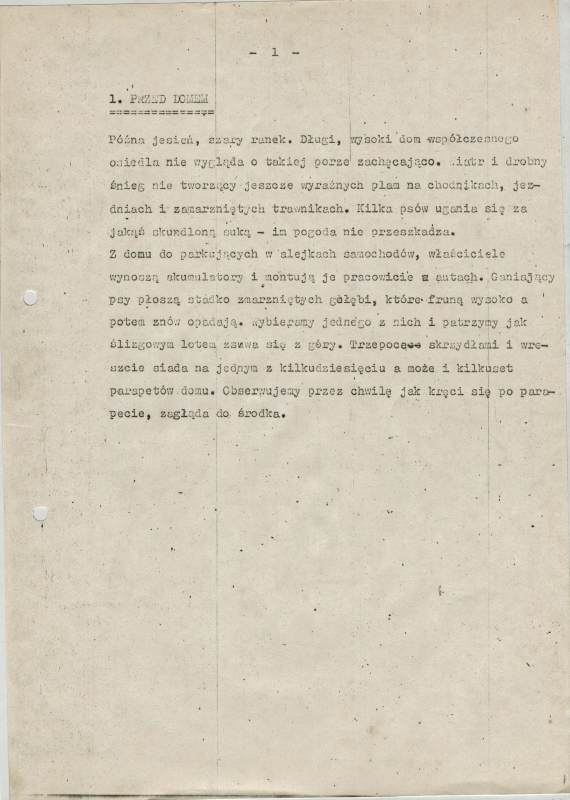
Decalogue One, Fragment 1
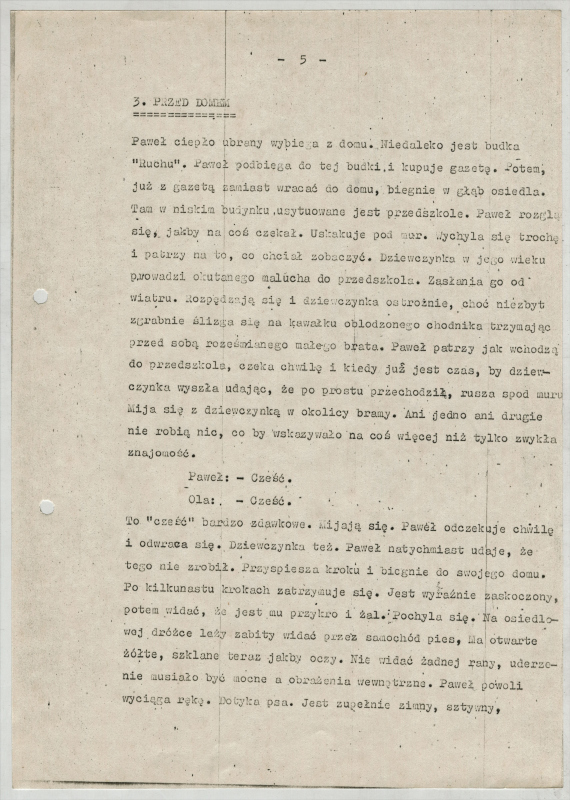
Decalogue One, Fragment 2, Page 1
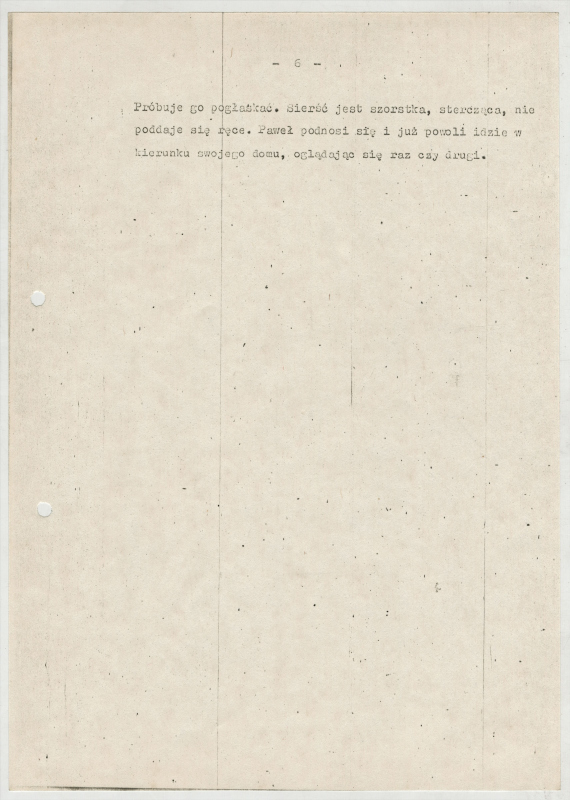
Decalogue One, Fragment 2, Page 2
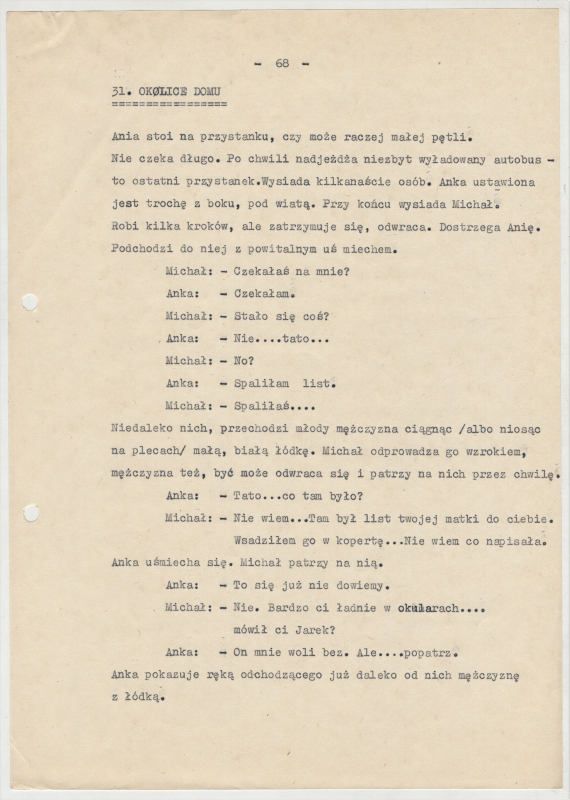
Decalogue Four, Fragment 1, Page 1

Decalogue Four, Fragment 1, Page 2
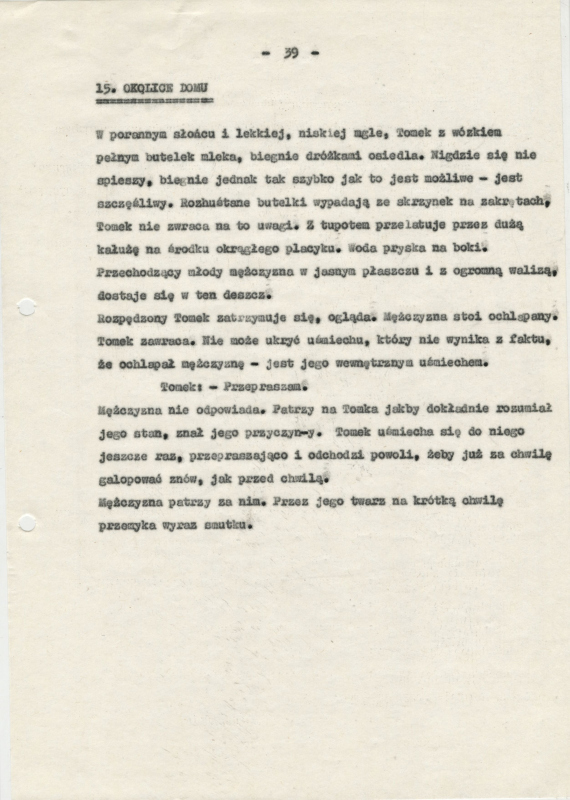
Decalogue Six, Fragment 1
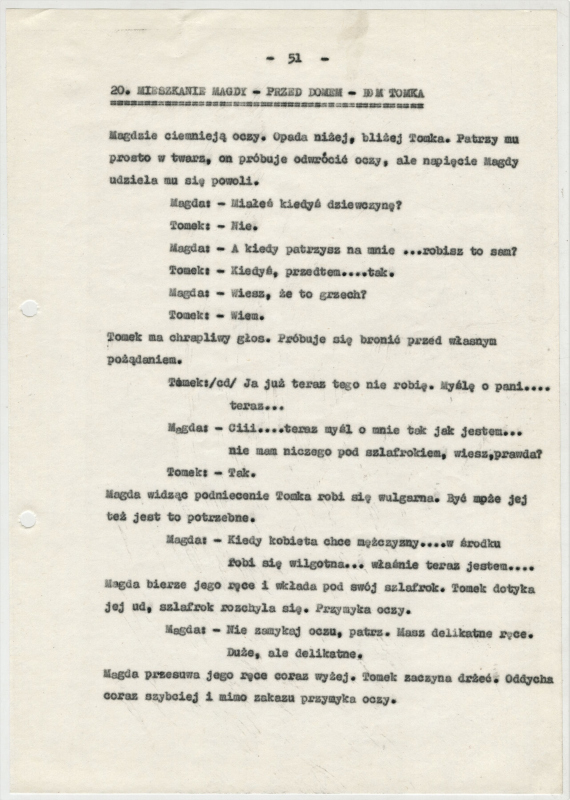
Decalogue Six, Fragment 2, Page 1
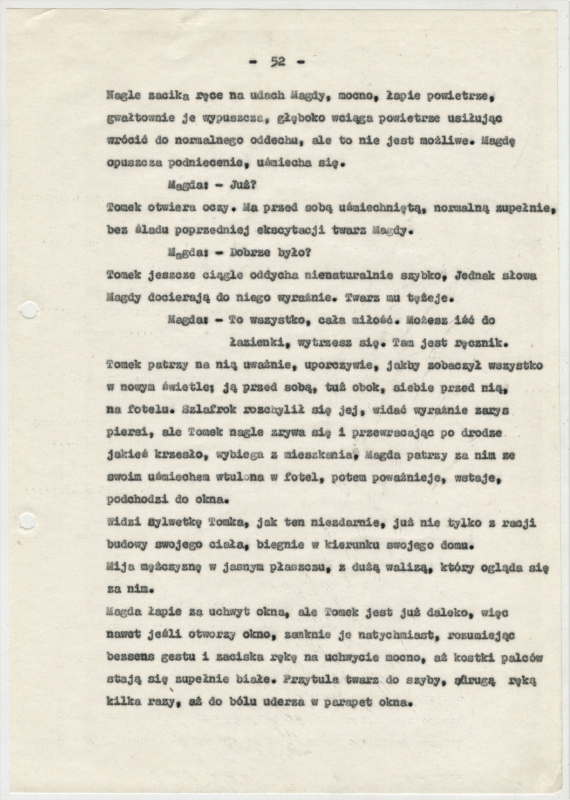
Decalogue Six, Fragment 2, Page 2
Decalogue One
Decalogue One
Decalogue One
Decalogue Four
Decalogue Six